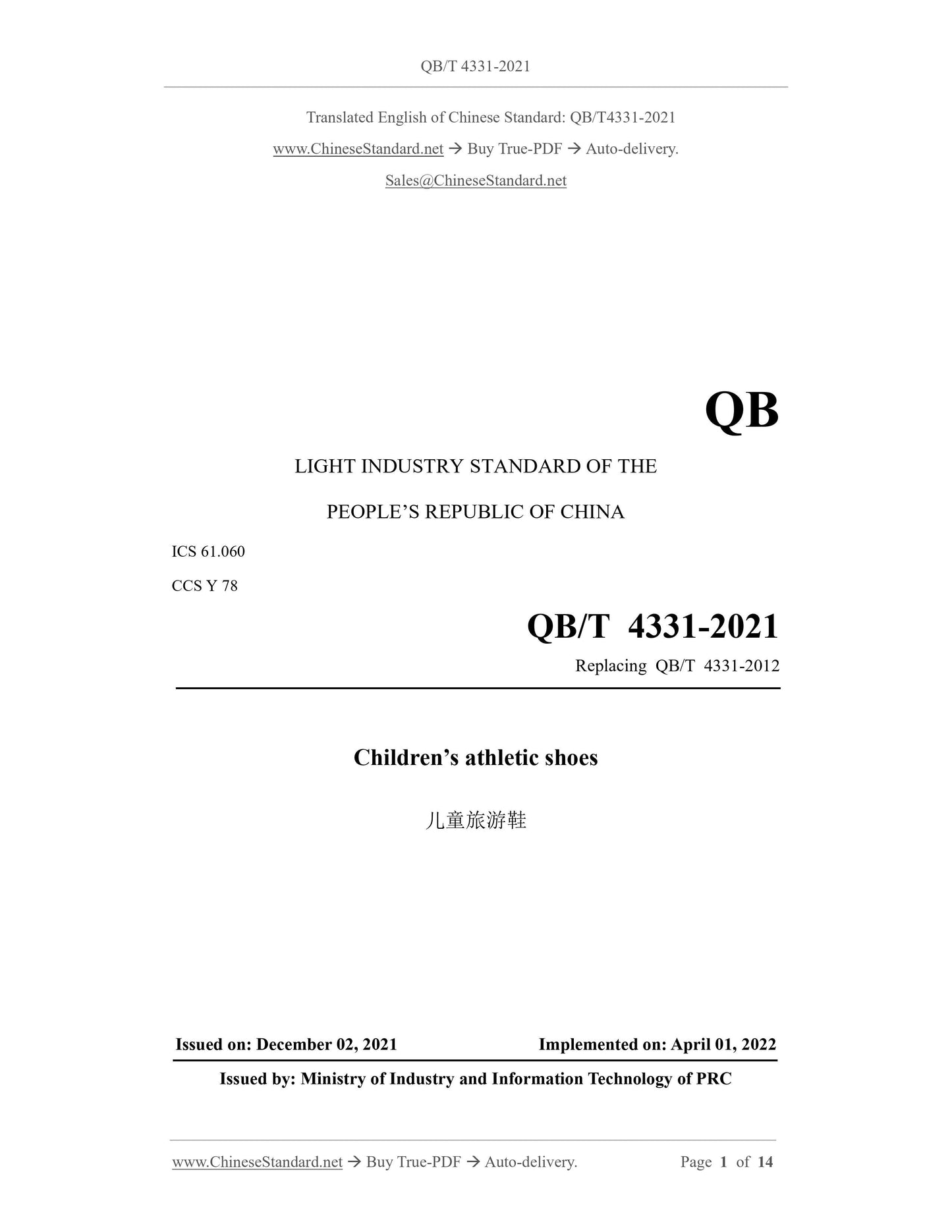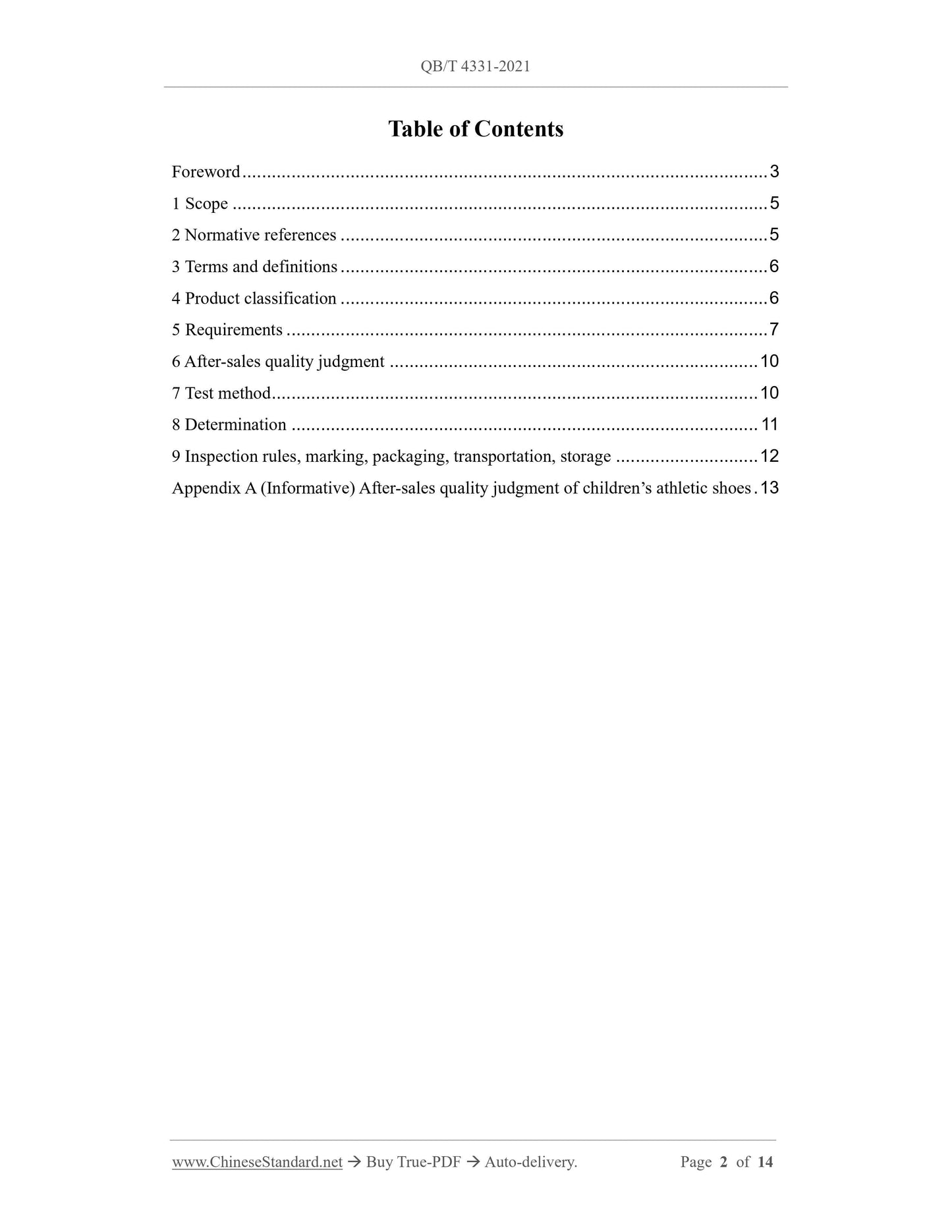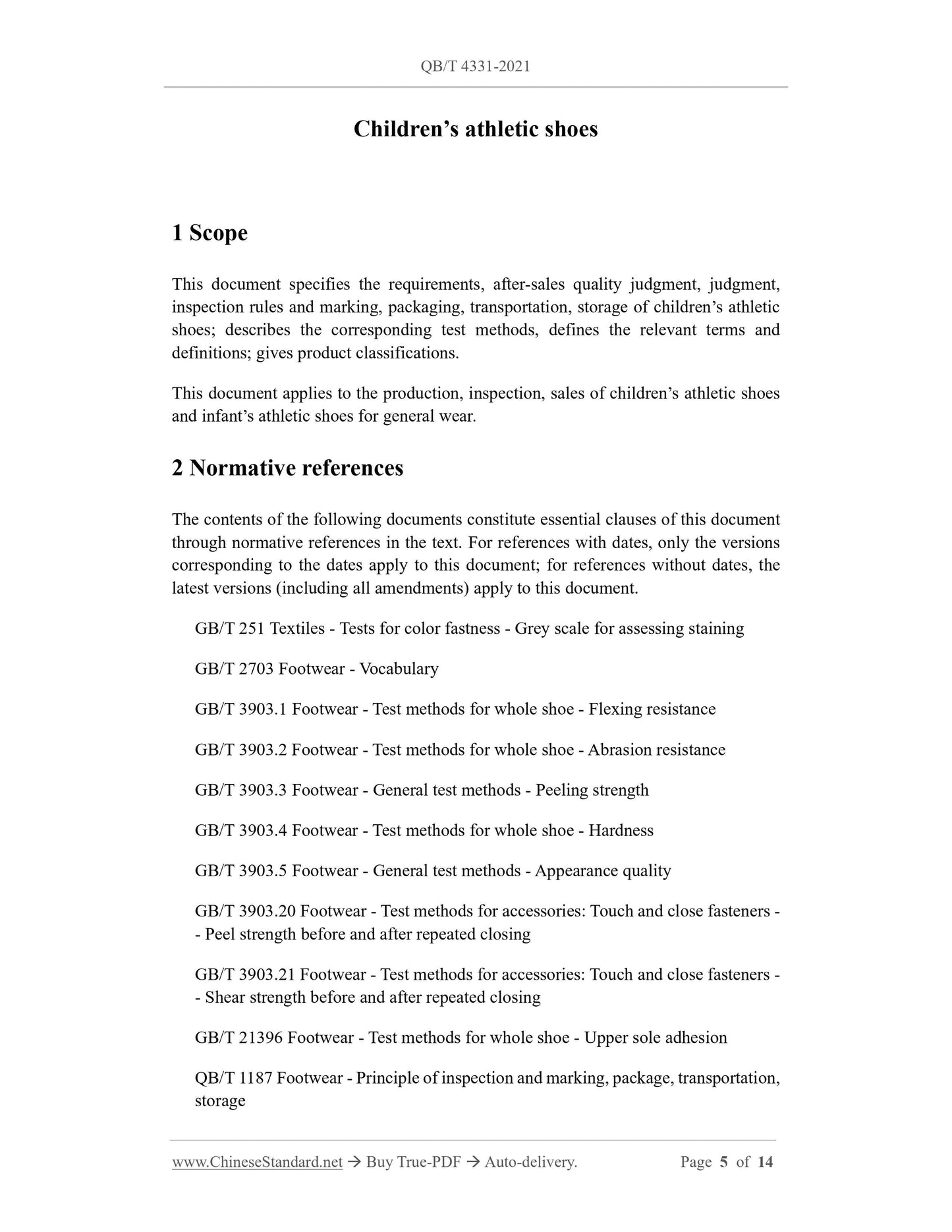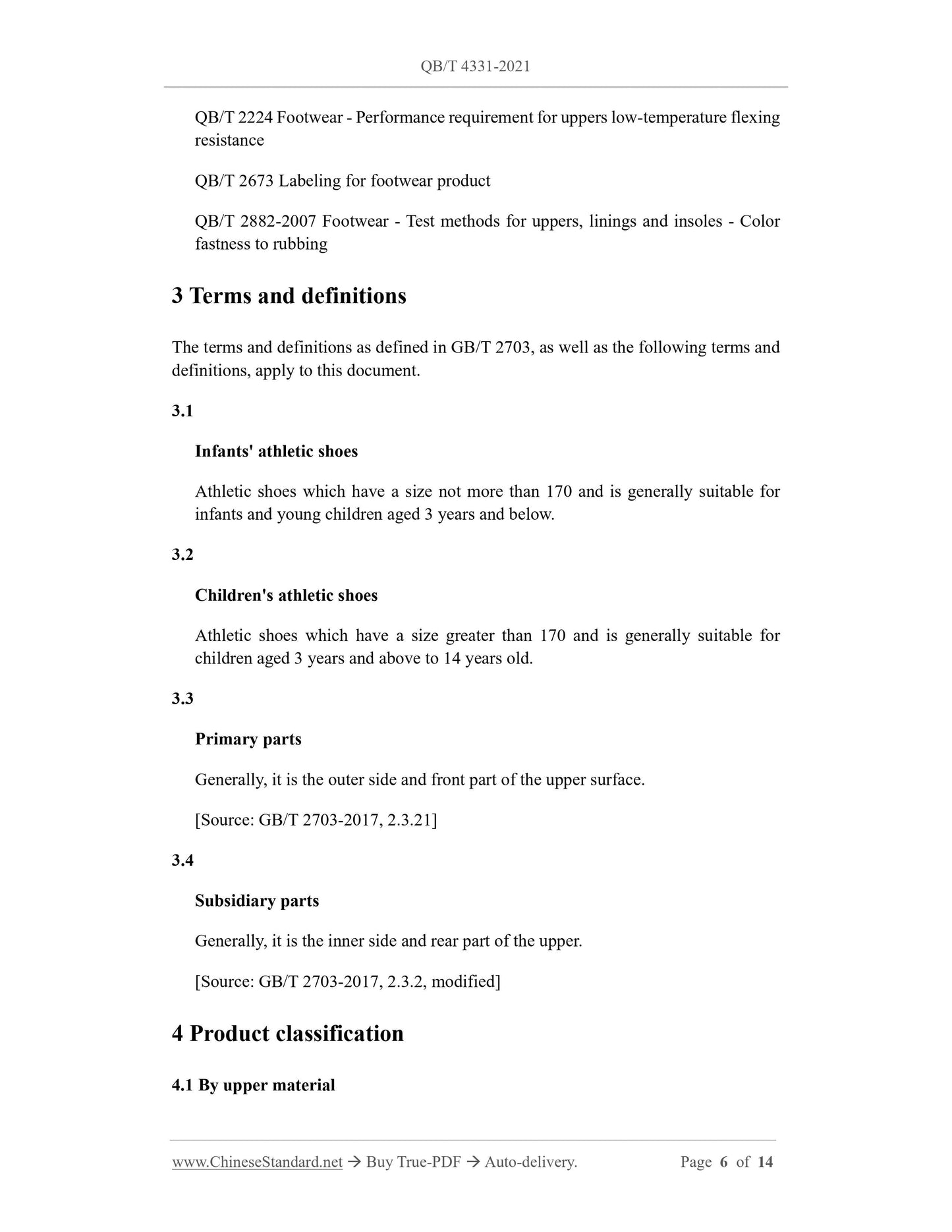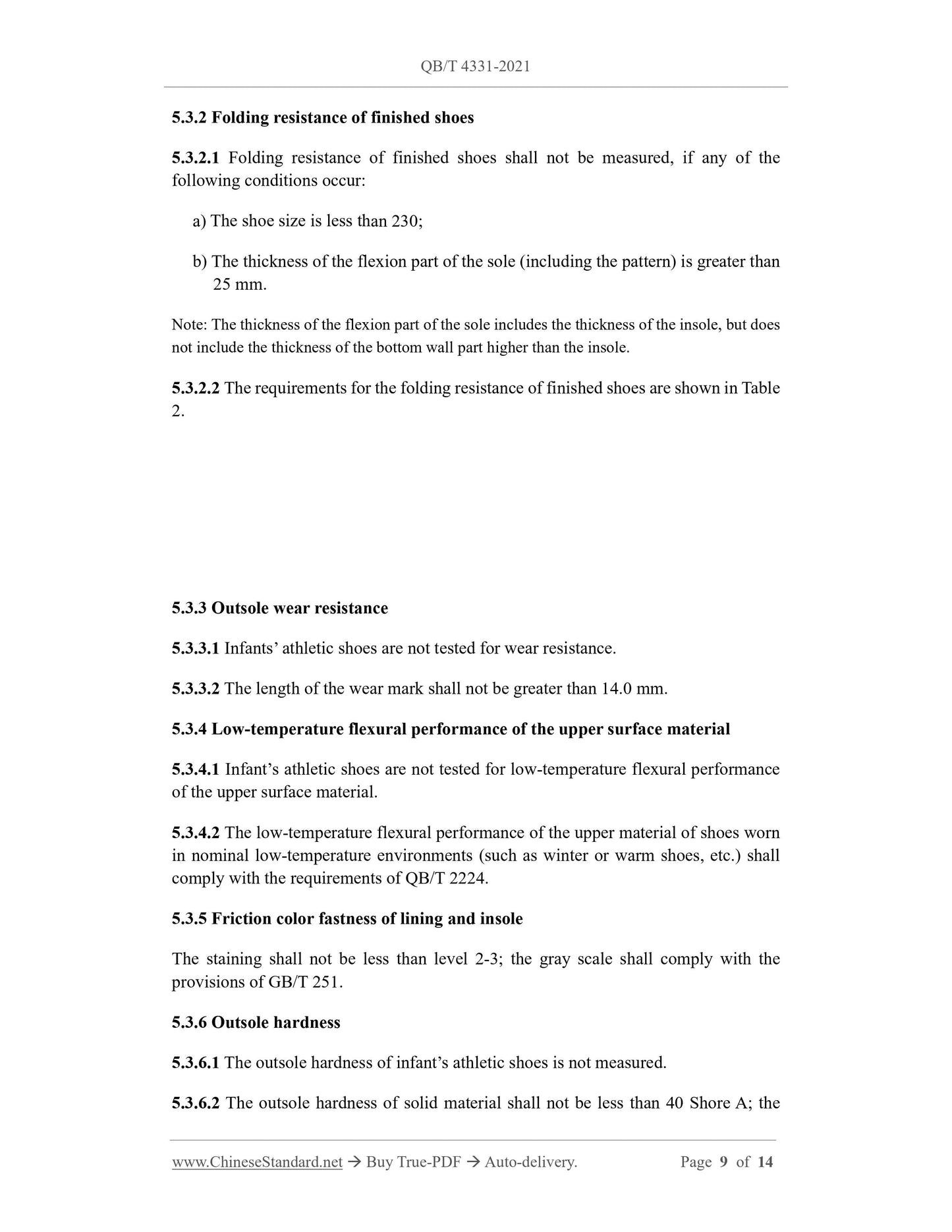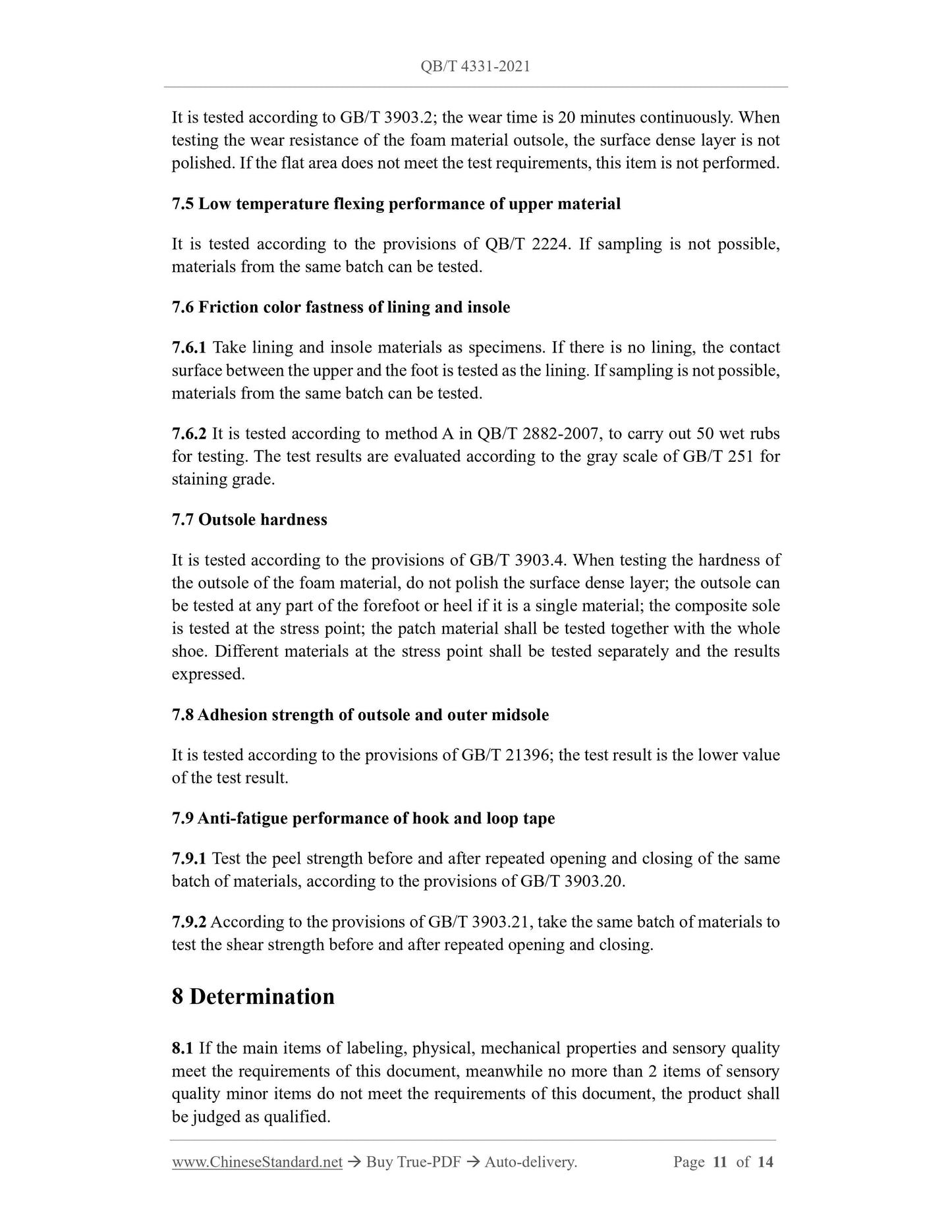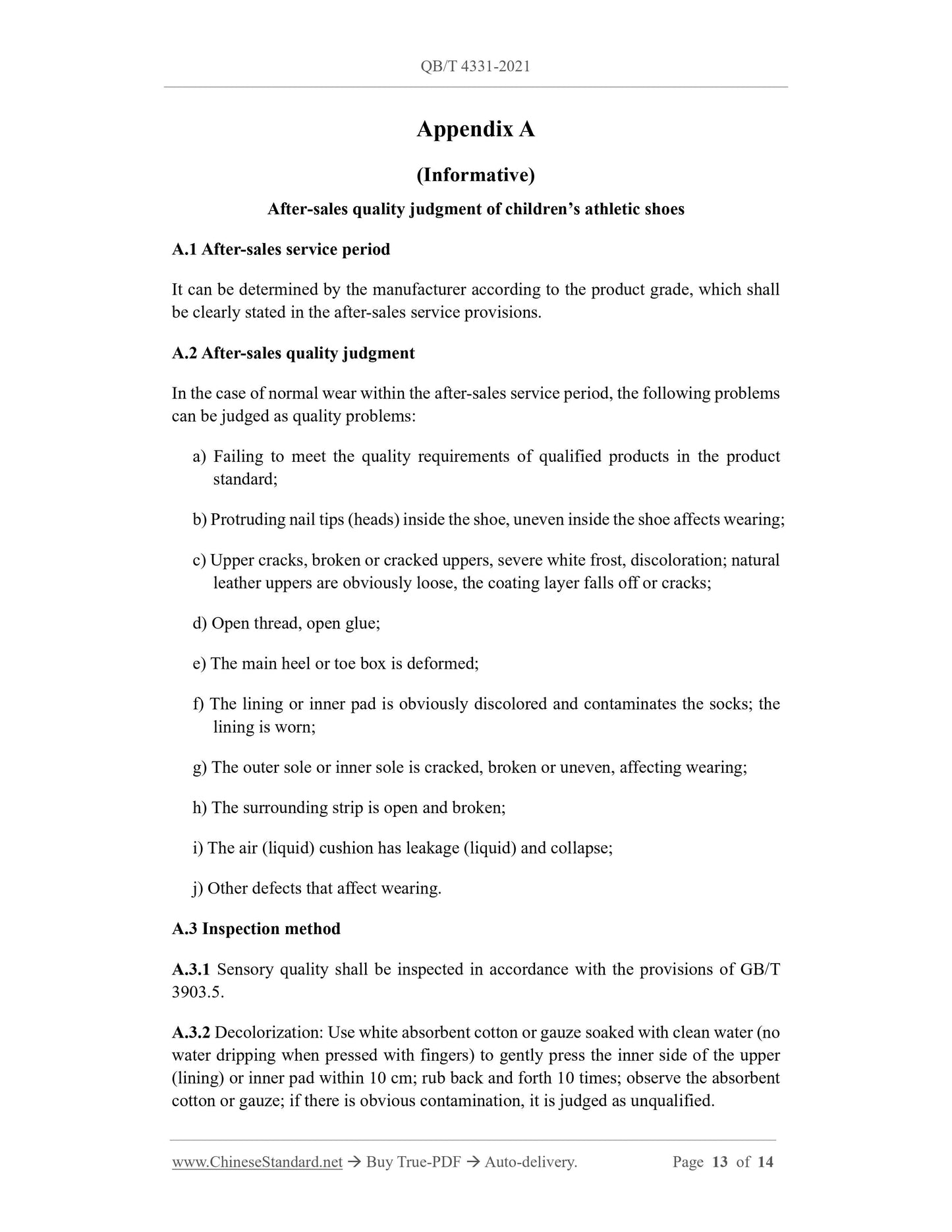1
/
of
7
PayPal, credit cards. Download editable-PDF and invoice in 1 second!
QB/T 4331-2021 English PDF (QBT4331-2021)
QB/T 4331-2021 English PDF (QBT4331-2021)
Regular price
$155.00 USD
Regular price
Sale price
$155.00 USD
Unit price
/
per
Shipping calculated at checkout.
Couldn't load pickup availability
Delivery: 3 seconds. Download true-PDF + Invoice.
Get QUOTATION in 1-minute: Click QB/T 4331-2021
Historical versions: QB/T 4331-2021
Preview True-PDF (Reload/Scroll if blank)
QB/T 4331-2021: Children athletic shoes
QB/T 4331-2021
QB
LIGHT INDUSTRY STANDARD OF THE
PEOPLE’S REPUBLIC OF CHINA
ICS 61.060
CCS Y 78
Replacing QB/T 4331-2012
Children’s athletic shoes
儿童旅游鞋
ISSUED ON: DECEMBER 02, 2021
IMPLEMENTED ON: APRIL 01, 2022
Issued by: Ministry of Industry and Information Technology of PRC
Table of Contents
Foreword ... 3
1 Scope ... 5
2 Normative references ... 5
3 Terms and definitions ... 6
4 Product classification ... 6
5 Requirements ... 7
6 After-sales quality judgment ... 10
7 Test method ... 10
8 Determination ... 11
9 Inspection rules, marking, packaging, transportation, storage ... 12
Appendix A (Informative) After-sales quality judgment of children’s athletic shoes . 13
Children’s athletic shoes
1 Scope
This document specifies the requirements, after-sales quality judgment, judgment,
inspection rules and marking, packaging, transportation, storage of children’s athletic
shoes; describes the corresponding test methods, defines the relevant terms and
definitions; gives product classifications.
This document applies to the production, inspection, sales of children’s athletic shoes
and infant’s athletic shoes for general wear.
2 Normative references
The contents of the following documents constitute essential clauses of this document
through normative references in the text. For references with dates, only the versions
corresponding to the dates apply to this document; for references without dates, the
latest versions (including all amendments) apply to this document.
GB/T 251 Textiles - Tests for color fastness - Grey scale for assessing staining
GB/T 2703 Footwear - Vocabulary
GB/T 3903.1 Footwear - Test methods for whole shoe - Flexing resistance
GB/T 3903.2 Footwear - Test methods for whole shoe - Abrasion resistance
GB/T 3903.3 Footwear - General test methods - Peeling strength
GB/T 3903.4 Footwear - Test methods for whole shoe - Hardness
GB/T 3903.5 Footwear - General test methods - Appearance quality
GB/T 3903.20 Footwear - Test methods for accessories: Touch and close fasteners -
- Peel strength before and after repeated closing
GB/T 3903.21 Footwear - Test methods for accessories: Touch and close fasteners -
- Shear strength before and after repeated closing
GB/T 21396 Footwear - Test methods for whole shoe - Upper sole adhesion
QB/T 1187 Footwear - Principle of inspection and marking, package, transportation,
storage
QB/T 2224 Footwear - Performance requirement for uppers low-temperature flexing
resistance
QB/T 2673 Labeling for footwear product
QB/T 2882-2007 Footwear - Test methods for uppers, linings and insoles - Color
fastness to rubbing
3 Terms and definitions
The terms and definitions as defined in GB/T 2703, as well as the following terms and
definitions, apply to this document.
3.1
Infants' athletic shoes
Athletic shoes which have a size not more than 170 and is generally suitable for
infants and young children aged 3 years and below.
3.2
Children's athletic shoes
Athletic shoes which have a size greater than 170 and is generally suitable for
children aged 3 years and above to 14 years old.
3.3
Primary parts
Generally, it is the outer side and front part of the upper surface.
[Source: GB/T 2703-2017, 2.3.21]
3.4
Subsidiary parts
Generally, it is the inner side and rear part of the upper.
[Source: GB/T 2703-2017, 2.3.2, modified]
4 Product classification
4.1 By upper material
5.3.2 Folding resistance of finished shoes
5.3.2.1 Folding resistance of finished shoes shall not be measured, if any of the
following conditions occur:
a) The shoe size is less than 230;
b) The thickness of the flexion part of the sole (including the pattern) is greater than
25 mm.
Note: The thickness of the flexion part of the sole includes the thickness of the insole, but does
not include the thickness of the bottom wall part higher than the insole.
5.3.2.2 The requirements for the folding resistance of finished shoes are shown in Table
2.
5.3.3 Outsole wear resistance
5.3.3.1 Infants’ athletic shoes are not tested for wear resistance.
5.3.3.2 The length of the wear mark shall not be greater than 14.0 mm.
5.3.4 Low-temperature flexural performance of the upper surface material
5.3.4.1 Infant’s athletic shoes are not tested for low-temperature flexural performance
of the upper surface material.
5.3.4.2 The low-temperature flexural performance of the upper material of shoes worn
in nominal low-temperature environments (such as winter or warm shoes, etc.) shall
comply with the requirements of QB/T 2224.
5.3.5 Friction color fastness of lining and insole
The staining shall not be less than level 2-3; the gray scale shall comply with the
provisions of GB/T 251.
5.3.6 Outsole hardness
5.3.6.1 The outsole hardness of infant’s athletic shoes is not measured.
5.3.6.2 The outsole hardness of solid material shall not be less than 40 Shore A; the
It is tested according to GB/T 3903.2; the wear time is 20 minutes continuously. When
testing the wear resistance of the foam material outsole, the surface dense layer is not
polished. If the flat area does not meet the test requirements, this item is not performed.
7.5 Low temperature flexing performance of upper material
It is tested according to the provisions of QB/T 2224. If sampling is not possible,
materials from the same batch can be tested.
7.6 Friction color fastness of lining and insole
7.6.1 Take lining and insole materials as specimens. If there is no lining, the contact
surface between the upper and the foot is tested as the lining. If sampling is not possible,
materials from the same batch can be tested.
7.6.2 It is tested according to method A in QB/T 2882-2007, to carry out 50 wet rubs
for testing. The test results are evaluated according to the gray scale of GB/T 251 for
staining grade.
7.7 Outsole hardness
It is tested according to the provisions of GB/T 3903.4. When testing the hardness of
the outsole of the foam material, do not polish the surface dense layer; the outsole can
be tested at any part of the forefoot or heel if it is a single material; the composite sole
is tested at the stress point; the patch material shall be tested together with the whole
shoe. Different materials at the stress point shall be tested separately and the results
expressed.
7.8 Adhesion strength of outsole and outer midsole
It is tested according to the provisions of GB/T 21396; the test result is the lower value
of the test result.
7.9 Anti-fatigue performance of hook and loop tape
7.9.1 Test the peel strength before and after repeated opening and closing of the same
batch of materials, according to the provisions of GB/T 3903.20.
7.9.2 According to the provisions of GB/T 3903.21, take the same batch of materials to
test the shear strength before and after repeated opening and closing.
8 Determination
8.1 If the main items of labeling, physical, mechanical properties and sensory quality
meet the requirements of this document, meanwhile no more than 2 items of sensory
quality minor items do not meet the requirements of this document, the product shall
be judged as qualified.
Appendix A
(Informative)
After-sales quality judgment of children’s athletic shoes
A.1 After-sales service period
It can be determined by the manufacturer according to the product grade, which shall
be clearly stated in the after-sales service provisions.
A.2 After-sal...
Get QUOTATION in 1-minute: Click QB/T 4331-2021
Historical versions: QB/T 4331-2021
Preview True-PDF (Reload/Scroll if blank)
QB/T 4331-2021: Children athletic shoes
QB/T 4331-2021
QB
LIGHT INDUSTRY STANDARD OF THE
PEOPLE’S REPUBLIC OF CHINA
ICS 61.060
CCS Y 78
Replacing QB/T 4331-2012
Children’s athletic shoes
儿童旅游鞋
ISSUED ON: DECEMBER 02, 2021
IMPLEMENTED ON: APRIL 01, 2022
Issued by: Ministry of Industry and Information Technology of PRC
Table of Contents
Foreword ... 3
1 Scope ... 5
2 Normative references ... 5
3 Terms and definitions ... 6
4 Product classification ... 6
5 Requirements ... 7
6 After-sales quality judgment ... 10
7 Test method ... 10
8 Determination ... 11
9 Inspection rules, marking, packaging, transportation, storage ... 12
Appendix A (Informative) After-sales quality judgment of children’s athletic shoes . 13
Children’s athletic shoes
1 Scope
This document specifies the requirements, after-sales quality judgment, judgment,
inspection rules and marking, packaging, transportation, storage of children’s athletic
shoes; describes the corresponding test methods, defines the relevant terms and
definitions; gives product classifications.
This document applies to the production, inspection, sales of children’s athletic shoes
and infant’s athletic shoes for general wear.
2 Normative references
The contents of the following documents constitute essential clauses of this document
through normative references in the text. For references with dates, only the versions
corresponding to the dates apply to this document; for references without dates, the
latest versions (including all amendments) apply to this document.
GB/T 251 Textiles - Tests for color fastness - Grey scale for assessing staining
GB/T 2703 Footwear - Vocabulary
GB/T 3903.1 Footwear - Test methods for whole shoe - Flexing resistance
GB/T 3903.2 Footwear - Test methods for whole shoe - Abrasion resistance
GB/T 3903.3 Footwear - General test methods - Peeling strength
GB/T 3903.4 Footwear - Test methods for whole shoe - Hardness
GB/T 3903.5 Footwear - General test methods - Appearance quality
GB/T 3903.20 Footwear - Test methods for accessories: Touch and close fasteners -
- Peel strength before and after repeated closing
GB/T 3903.21 Footwear - Test methods for accessories: Touch and close fasteners -
- Shear strength before and after repeated closing
GB/T 21396 Footwear - Test methods for whole shoe - Upper sole adhesion
QB/T 1187 Footwear - Principle of inspection and marking, package, transportation,
storage
QB/T 2224 Footwear - Performance requirement for uppers low-temperature flexing
resistance
QB/T 2673 Labeling for footwear product
QB/T 2882-2007 Footwear - Test methods for uppers, linings and insoles - Color
fastness to rubbing
3 Terms and definitions
The terms and definitions as defined in GB/T 2703, as well as the following terms and
definitions, apply to this document.
3.1
Infants' athletic shoes
Athletic shoes which have a size not more than 170 and is generally suitable for
infants and young children aged 3 years and below.
3.2
Children's athletic shoes
Athletic shoes which have a size greater than 170 and is generally suitable for
children aged 3 years and above to 14 years old.
3.3
Primary parts
Generally, it is the outer side and front part of the upper surface.
[Source: GB/T 2703-2017, 2.3.21]
3.4
Subsidiary parts
Generally, it is the inner side and rear part of the upper.
[Source: GB/T 2703-2017, 2.3.2, modified]
4 Product classification
4.1 By upper material
5.3.2 Folding resistance of finished shoes
5.3.2.1 Folding resistance of finished shoes shall not be measured, if any of the
following conditions occur:
a) The shoe size is less than 230;
b) The thickness of the flexion part of the sole (including the pattern) is greater than
25 mm.
Note: The thickness of the flexion part of the sole includes the thickness of the insole, but does
not include the thickness of the bottom wall part higher than the insole.
5.3.2.2 The requirements for the folding resistance of finished shoes are shown in Table
2.
5.3.3 Outsole wear resistance
5.3.3.1 Infants’ athletic shoes are not tested for wear resistance.
5.3.3.2 The length of the wear mark shall not be greater than 14.0 mm.
5.3.4 Low-temperature flexural performance of the upper surface material
5.3.4.1 Infant’s athletic shoes are not tested for low-temperature flexural performance
of the upper surface material.
5.3.4.2 The low-temperature flexural performance of the upper material of shoes worn
in nominal low-temperature environments (such as winter or warm shoes, etc.) shall
comply with the requirements of QB/T 2224.
5.3.5 Friction color fastness of lining and insole
The staining shall not be less than level 2-3; the gray scale shall comply with the
provisions of GB/T 251.
5.3.6 Outsole hardness
5.3.6.1 The outsole hardness of infant’s athletic shoes is not measured.
5.3.6.2 The outsole hardness of solid material shall not be less than 40 Shore A; the
It is tested according to GB/T 3903.2; the wear time is 20 minutes continuously. When
testing the wear resistance of the foam material outsole, the surface dense layer is not
polished. If the flat area does not meet the test requirements, this item is not performed.
7.5 Low temperature flexing performance of upper material
It is tested according to the provisions of QB/T 2224. If sampling is not possible,
materials from the same batch can be tested.
7.6 Friction color fastness of lining and insole
7.6.1 Take lining and insole materials as specimens. If there is no lining, the contact
surface between the upper and the foot is tested as the lining. If sampling is not possible,
materials from the same batch can be tested.
7.6.2 It is tested according to method A in QB/T 2882-2007, to carry out 50 wet rubs
for testing. The test results are evaluated according to the gray scale of GB/T 251 for
staining grade.
7.7 Outsole hardness
It is tested according to the provisions of GB/T 3903.4. When testing the hardness of
the outsole of the foam material, do not polish the surface dense layer; the outsole can
be tested at any part of the forefoot or heel if it is a single material; the composite sole
is tested at the stress point; the patch material shall be tested together with the whole
shoe. Different materials at the stress point shall be tested separately and the results
expressed.
7.8 Adhesion strength of outsole and outer midsole
It is tested according to the provisions of GB/T 21396; the test result is the lower value
of the test result.
7.9 Anti-fatigue performance of hook and loop tape
7.9.1 Test the peel strength before and after repeated opening and closing of the same
batch of materials, according to the provisions of GB/T 3903.20.
7.9.2 According to the provisions of GB/T 3903.21, take the same batch of materials to
test the shear strength before and after repeated opening and closing.
8 Determination
8.1 If the main items of labeling, physical, mechanical properties and sensory quality
meet the requirements of this document, meanwhile no more than 2 items of sensory
quality minor items do not meet the requirements of this document, the product shall
be judged as qualified.
Appendix A
(Informative)
After-sales quality judgment of children’s athletic shoes
A.1 After-sales service period
It can be determined by the manufacturer according to the product grade, which shall
be clearly stated in the after-sales service provisions.
A.2 After-sal...
Share
